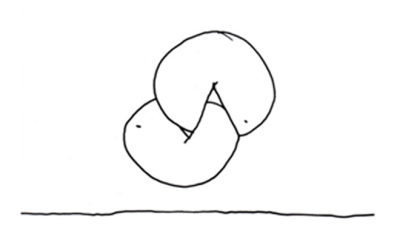
7 Steps to Loving Yourself
“A troop of porcupines is milling about on a cold winter’s day. In order to keep from freezing, the animals move closer together. Just as they are close enough to huddle, however, they start to poke each other with their quills. In order to stop the pain, they spread out, lose the advantage of commingling, and again begin to shiver. This sends them back in search of one and other, and the cycle repeats as they struggle to find a comfortable distance between entanglement and freezing.” Arthur Shopenhauer
We are wired for love and connection. Without it, as babies, we don’t survive. Without it, as adults, we can’t thrive. Self-actualization simply doesn’t happen inside a vacuum. We need others in order to be and share our best. While in the 1950’s psychologists still believed that children shouldn’t be coddled, nowadays scientists are certain of the detrimental effect that lack of warmth and closeness has not only in childhood but in adulthood as well. Conventional wisdom held that mothers who coddled their offspring created clingy, over dependent youngsters who grew up into incompetent adults. The proper way to rear children was to have an antiseptic, rational distance. In those days, for example, parents weren’t allowed to stay in the hospital with their sick sons and daughters; they had to drop the children off at the door.
The troubling effects of this were documented by John Bowlby. It was he who revolutionized this area of psychology by introducing “Attachment Theory”, which was initially ridiculed and despised by his peers. This theory supports a child’s need for safe, ongoing physical and emotional closeness. In the 1990s this theory was broadened to include adults: having a secure connection to our loved ones is empowering. It allows us to thrive.
And so we have an innate desire for community and connection. As the porcupines in Shopenhauer’s fable however, closeness comes with the risk of getting hurt. We prick each other with our figurative quills and then we retreat to keep a safe distance. To create a sense of emotional safety we tend to do one of two things: either we strive for closeness at our own detriment, not setting any boundaries and allowing ourselves to be treated badly for the sake of keeping the connection. We won’t say no because we fear abandonment. Alternatively, we set up walls and fences, not letting anyone get close, in an effort to keep ourselves safe. Accepting help is out of the question and those softer emotions like intimacy, love and care are kept at bay.
Neither strategy gets us what we truly want. It creates a false sense of security that eventually will lose its effectiveness. Shopenhauer saw this dance of separateness and closeness as an inevitable dichotomy. I don’t agree with him. I strongly believe it is possible to synergize the two and build our connections on “effective dependency”. It means being separated (independent) enough to truly bond and allow yourself to be dependent on someone else. This certainly doesn’t mean you’ll never get hurt. It simply means that you’ll have a healthy way of relating to this hurt, so that your emotional safety comes from within first and foremost. You fully accept that risk, because you can choose with whom to connect and with whom not.
My belief in this synergy did not automatically mean I experienced it in my own life. In fact, it has been quite the contrary. I’ve struggled with maintaining my autonomy and feeling truly connected at the same time. For a long time I was stuck in either feeling completely true to myself, yet alone, or in deep connection with others yet losing myself in the meantime. My desire for connection was so great that I would forget (or, to be honest, flat out refuse) to set conditions to the relationship, whether it be a friendship, love relationship or even in my work. If the other person wasn’t carrying their weight in our relating, I would pick up the slack for them.
A great example of this happened with a friend of mine in high school who lived about 5 miles away from me. Those miles always seemed a lot farther for her than they did for me. So I ended up cycling her way 98% of the time, which was metaphorical of our connection. That kind of lob-sidedness in any kind of relationship won’t hold forever, unless of course, you’re willing to lose yourself in the meantime.
My love relationships weren’t much different. In my wanting for others what they want for themselves, I would simply lose connection with what I wanted and needed for me. Then when I would eventually awaken to that again, I found myself in a situation where the other person wouldn’t reciprocate nor was willing to extend themselves. In fact, as I started to take care of myself first, they’d feel betrayed by my sudden “lack of care”.
The pain that came from that has led me to explore and uncover the ingredients of how to love yourself and your relationships. How can we be an expression of our authentic essence and truly connect with those we care about? What needs to be present in a connection for it to be able to flourish and strengthen over time? I started reading books on boundaries, on connections and relationships and all things concerning authenticity and autonomy. I’ve spoken to countless of people, got coaching and coached others on this topic. Through all of it I started to notice patterns. The same essential ingredients seemed to be presented in everything I read or heard and experienced in my own life. And so my research, my work with my clients and experimentation in my personal life has led me to a 7-step system that focuses on building a strong inner bond from which we can grow sustainable, loving connections.
Step 1: Pair up with love — learn to love yourself unconditionally
The one thing that separates men and women who feel a deep sense of love and belonging from those who don’t is worthiness. They believe that they are worthy of love and belonging. It’s a worthiness that is independent of what other people think of you, independent of mistakes you’ve made in your life or the kind of childhood you’ve had. The thing about this kind of worthiness is that it is unconditional. It just is. Your actions – “good or bad” – don’t have any effect on your self-esteem. Imagine having that kind of self-love. How much easier will it be to take risks, to extend yourself, to be authentic? How much kinder will you be on yourself? And how much more compassion does that allow you to feel for others?
Step 2 — Exclusion/Inclusion — know your boundaries
Having healthy boundaries firmly in place is critical for creating a strong inner bond and experiencing emotional safety. That’s because boundaries let love in and keep out anything that destroys love. So this step is all about discovering your values and violations, feeling and acting on the yeses and no’s in your life in a calm assertive way. It also addresses the difference between what you are responsible for (your own values and needs, violations and limits) and what you aren’t (someone else’s). This builds integrity and authenticity. A place where you no longer lose yourself in someone else’s needs or demands.
This step is about self-empowerment and taking charge of your own happiness, since you’ll only focus on the things that are in your control.
Step 3 – Part ways with toxic beliefs and troubling emotions
Most of us feel ashamed of our vulnerabilities, though they’ll differ for each of us. Some might feel vulnerable in anger and frustration, others in joy, intimacy or sadness. And so we try to hide them: Shame loves secrecy. As these emotions are tabooed in our lives, we (try to) numb ourselves from what we despise feeling. And what we reject within ourselves, we also reject in others.
In addition, there are the fears that we fear so much we will do anything to avoid going there. Fear of abandonment, fear of rejection, fear of failure and not being perfect. The stronger the fear, the more it drives us – and we can be quite unaware that it is in fact the emotion that is in control! We might also be painfully aware of it, yet unable to do something about it.
Step 3 teaches you a healthy relationship with all range of emotions so that they can inform you. Emotions aren’t good or bad, positive or negative. We make them positive or negative through the way we relate to them. In allowing ourselves to feel every emotion, we can witness and express them. That way you don’t need to feel stuck or paralyzed in an emotion, or have the urge to fight it or numb ourselves from them. It allows you to quality control the beliefs that trigger your emotions, sit with reality as it is and take effective action accordingly.
This creates the emotional freedom for you to be with the emotions of yourself and others without the need to change them. It allows you to listen, to connect, and when needed even to challenge in a kindly firm way.
Step 4 – Practice letting go of outcomes/expectations
In our interactions with other human beings, the other person is free to walk with us or to go away. As we are creating a strong inner bond and become ever more authentic in our actions, it might mean that others aren’t willing to walk alongside with us. That is their prerogative. Our fear of someone leaving however might stop us from being true to ourselves. We may end up selling ourselves out (or short) because we fear what the other person might do when we tell them our truth. Or we might become manipulative and controlling in our dealings with others. The ability to let go of the outcome and to be ok with whatever outcome is critical for establishing and maintaining a strong inner bond as well as an authentic connection with our loved ones. It allows us to take decisions earlier and we no longer feel the need to manipulate the outcome or ignore the reality of what is. This gives way to a sense of inner peace and what I like to call “cosmic faith”: whatever happens, it will be ok.
Step 5: Express your truth – risk honesty and vulnerability
As you let go of expectations and outcomes, it becomes a great deal easier to speak your truth. This step is about speaking honestly about who you are, what you are feeling, about your experiences (good or bad). In it, we risk feeling vulnerable. We risk being misunderstood, not heard, rejected and ridiculed. And yet, it is necessary for experiencing true intimacy, joy, love and belonging. It takes courage to do so. Courage originally meant “to speak one’s mind with all one’s heart”. It’s our chance of showing others who we are.
Step 6: Responsiveness – being emotionally responsive
Boundary-setting and saying no is a critical component of compassion. It’s much harder to hear and respond to someone else’s needs when we are not compassionate towards ourselves first. Or when we don’t say no and start to feel resentment towards the other person. We need to be fully authentic and real in order to have the emotional freedom to truly, deeply listen to the emotional needs of the other person.
Step 6 answers the question of how to be a “safe” person for others to connect with.
This step is also about recognizing emotional responsiveness in others. People who are “safe” to connect with will be empathetic to your needs and willing to dance with your needs as they care and speak up for their own.
Step 7 – Synergize – come from a place of abundance and resourcefulness
Part of a successful connection that is sustainable and grows stronger in the long run is when both parties have an outlook of abundance and resourcefulness. Believing that there’s win/win allows you to get the best possible outcome for both. It stops you from dwelling on problems or things that happened in the past and opens the door to solutions and possibilities.
Oscar Wilde wrote “that to love one-self is the beginning of a life-long romance”. We can hardly be intimately connected with others if we have abandoned ourselves in the meantime. Loving yourself is the stepping stone to loving life and to loving others. It allows us to have a love affair with life itself. Of course we can choose to ignore the lack of connection and loneliness you feel in some or all of our relationships. Numbing yourself can be quite comfortable and the usual “TLC” replacements (food, alcohol, work, shopping) are far simpler to reach out to and obtain. Still how meaningful would that be in the end? Wouldn’t you rather have that love affair? Wouldn’t you like to be able to say that you’ve truly lived and deeply loved? I know I would.







